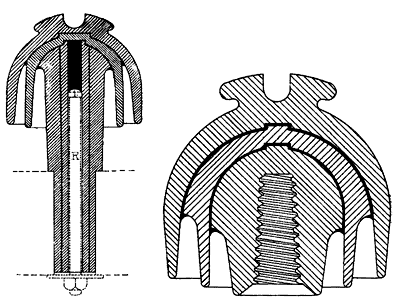[Trade Journal]
Publication: American Electrician
New York, NY, United States
vol. 10, no. 4, p. 178, col. 2-3
HIGH VOLTAGE INSULATORS.
In the article in the March issue on the Delta transmission plant, mention was made of the high voltage insulators used, of which we are now enabled to present an illustration. These insulators are of the "Boch" glazed and filled type, and are made in three parts of a uniform thickness, thus overcoming the danger in porcelain manufacture of cracks which are sure to occur where there is a thick part and a much thinner part to be dried and fired. Each of the three parts is thoroughly covered inside and out with a glazing, then fitted together, ready for the vitrified kiln, by being placed in the saggers upside down like an inverted bowl. A glazing material is then put into the joints, that is, into the annular channels between the petticoats.
The parts thus put together and supplied with glazing material, are then placed in a kiln, in which, under great heat, the clay shrinks and becomes vitrified and the glazing melts and become of a glass-like character. The glaze which was put into the annular channels between the petticoats flows down into and fills all the spaces between the parts of the insulators. The result is that the three parts are firmly united to each other throughout by means of the glass-like glaze, thus, as will readily be seen, insuring both electrical and mechanical strength.
The six skins of glaze and the two solid walls of glaze or glass formed by this method of manufacture, give an insulator that will stand up under almost any voltage, no matter what the general conditions may be. The insulators used at Delta were, before shipping, subjected to a test of 50,000 volts by being placed in salt brine upside down with salt brine put into the third petticoat or pin hole, one pole being in the pan and the other in the testing pin hole.
 |
| Figs. 1 and 2. - High Voltage Insulators. |
Since writing the above another patent has been issued to Mr. Boch for the insulator shown in Fig. 1. The object of this construction is to prevent arcing from the edges of the petticoat during wet weather, this being guarded against by mounting the petticoat body on a porcelain post, which passes down through an opening in the wooden cross-arm or support, the metal fastening being secured in the porcelain post by suitable cement. Thus it will be seen that the metal pin is so well protected by the tubular post which sheaths it and passes down through the cross-arm, that leakage of current or arcing across from the petticoats to the pin (liable to occur on high potential circuits of present construction) is thereby entirely obviated, as the exposed end of the pin, its nut and washer on the under side of the cross-arm, are too far away from the conductor to give trouble.
